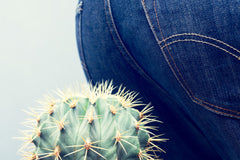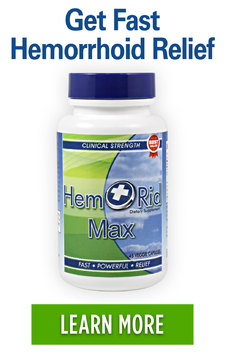Do Piles Itch and Burn? Get Relief from Itchy and Burning Hemorrhoids
Posted on 09 September 2018 by Maryanne Johnson
Share this post
Do your piles itch and burn? If you are unfamiliar with the itching and burning sensation that suddenly erupts from your anorectal area, impeding movements, your daily activities, and even what used to be formally comfortable positions, then this could be your first bout of hemorrhoids, or what most people refer to as piles.
Piles are an anorectal condition so common that nearly half of adults in the UK will develop it as they approach 50 years of age and older.
The stigma surrounding hemorrhoids creates a social discouragement of discussing symptoms and discomforts that arise when piles develop, and this discourages many sufferers from seeking medical advice from their GPs.
Piles that are left untreated, however, can worse, and although they are not a fatal disorder, piles can disrupt everyday life and induce a great deal of pain to those who struggle with reoccurring flare-ups.
In many cases of piles in which patients neglected to report to their physician, surgical intervention was required to resolve swollen hemorrhoidal columns or completely remove hemorrhoids altogether, either via stapling procedures, a hemorrhoidectomy, artery or band ligations, or other means of invasive operations.
These procedures leave patients with long periods of needed recovery time where they experience pain and common complications from invasive surgeries, and while this is an exchange to relieve themselves of hemorrhoids, there is no guarantee that their piles will not reappear in the future.
If you are beginning to experience the symptoms of piles, it is best to treat them early on before complicated surgeries are required that lead to long, strenuous, and often painful recovery times.
Treatment methods for the common symptoms of itching and burning are much simpler and less involved than even non-operative procedures for hemorrhoids.
Why Do Piles Itch and Burn?
Piles are mostly associated with itching and burning, and understanding how piles form can allow you to comprehend why and how these symptoms present themselves.
The term "piles" accurately describes what this condition looks like when it appears externally near the anus. These piles are blood vessels, tissues, and veins, which have become swollen because, for whatever reason, the blood supply to the sensitive rectal area was restricted.
Because hemorrhoids are the rectal veins running through the course of the lower rectum, either inside the anal canal or beneath the skin’s surface, they can take formation outside of the body, or internally, inside of the rectum. Internal hemorrhoids and external hemorrhoids can occur simultaneously, to the dismay of the person experiencing them.
Numerous factors can inflame the anal cushions; some are uncontrollable, while others have much to do with diet and lifestyle. For hemorrhoids, either internal or external, sufferers tend almost always to experience the same symptoms, and this is why when many patients explain their symptoms to their GP, the physician knows there is a strong likelihood that hemorrhoids are to blame.
Internal piles, however, tend only to be noticed by the single symptom of painless rectal bleeding, but occasionally, internal piles can present mild to severe anal itching.
When internal hemorrhoids prolapse, there is a much higher risk of pruritus ani, as the base of the hemorrhoidal column can attract and collect strains of particles from stools, mucus, and rectal discharge, worsening anal itch.
The inflamed veins and collection of blood vessels in the anorectal area are also the cause for the burning sensation felt by hemorrhoids. Sensitivity near and around the anus is heightened, especially when external piles have formed, and these rubbery lumps throb, ache, and can burn due to the interfered blood flow.
External piles are the more painful of the two because there are more nerve endings present beneath the skin outside of the rectal area in comparison to the inside of the rectum, where there is an absence of pain-sensing nerve endings.
With external piles, you may be more attuned to the itching and burning feelings than with internal piles.
How Do Itchy and Burning Piles Occur?
The blood vessels, connective tissues, and arteries that run along the venous channels to deliver the plentiful supply of blood suffer especially when there are issues of straining, like constipation, childbirth, and even lifting heavy objects.
Straining places excess stress on the anorectal veins, which then disrupts the flow of blood to the needed areas surrounding the rectum and anal region, therefore resulting in the inflammation known as piles.
People who are overweight can also develop piles. The excess weight places unneeded pressure on anorectal veins, which leads to the development of inflammation and piles, either internally or externally.
Similarly, pregnancy and the continuous growth of the uterus restrict the veins in the anorectal area, causing prevalent or reoccurring hemorrhoids.
Researchers and scientists are still searching for the real reason why hemorrhoids are such a prevalent condition, especially amongst older adults. Some hypothesize that as we age, the tissues weaken and fail to support essential veins and arteries of the anorectal area, leading to the development of frustrating piles, both internal and external.
People nearing or over the age of 50 are more likely to experience hemorrhoids than those who are younger, but this doesn’t mean that piles do not develop in young adults—and children. Constipation is a driving factor, and many people, no matter their age, struggle with chronic constipation.
Other issues that involve gastrointestinal disease and conditions such as Chron’s Disease, diverticulitis, Irritable Bowel Syndrome (IBS), or Celiac Disease all play an essential role in toilet habits, which can dictate hemorrhoidal development.
Family genetics will also play a role in the itching and burning sensations as well as the commonality of hemorrhoidal formations.
If people in your family are likely to experience piles, then you may be as well, including all of the accompanying symptoms such as itching and burning.
While it may seem nearly impossible to curb the flare-ups of piles because of genetic history, there are plenty of methods you can implement to prevent piles from taking formation internally and externally.
What to do to Relieve Itching and Burning
Itching and burning can be extremely disruptive to daily activities and even impede upon regular movements and sitting or standing positions. With piles, especially external piles, it seems like everything becomes ten times more difficult and painful to achieve.
Itching and burning are the two most commonly reported symptoms of piles, but luckily, there are plenty of means to help subside them to resume your normal day-to-day routine.
Topical treatments designed to target hemorrhoidal relief are an excellent at-home method to treat itching and burning. Follow the instructions listed on any of the packaging labels of the product you choose to utilize for piles relief.
Suppositories, wipes, and creams can all three be used to treat piles and temporarily act as an alleviation for symptoms. Many of these treatments should be used following a bowel movement, but it is crucial to follow the instructions for best usage.
What Do Doctors Recommend for Itchy and Burning Hemorrhoids?
Your GP will likely advise you to partake in a sitz bath. It is widely believed that by soaking the anorectal area in warm water and submerging it for fifteen to twenty minutes per day can you reduce the pain of the itching and burning symptoms, and also inflammation of the swollen rectal veins.
With warm water, and the additives of Epsom salts, essential oils, and other calming bath goods, you can at the very least temporarily relieve itching and burning of your piles.
Most importantly is the modification of your diet and lifestyle, as your GP will surely inform you of.
Only by altering your diet to a more fibrous one and your lifestyle to adapt plenty of exercise and hydration can you genuinely prevent hemorrhoids from developing.
Your GP may recommend taking a haemorrhoidal supplement or a fibre supplement to compensate your diet to produce softer, bulkier stools that contain more moisture and are easier to pass, reducing the probability of straining.
Ultimately, yes, piles itch and burn, but there are numerous methods of treatment available to try in the comfort of your own home to reduce these annoying and disruptive symptoms.
Talking to your GP and attempting a few remedies yourself can lessen these symptoms and make your piles more manageable.





0 comments